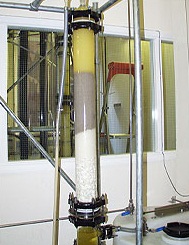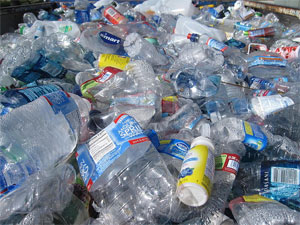Shelley Howard was a senior at the University of Southern California majoring in Chemical Engineering in the spring of 2004. In the future, she would like to further investigate, design, and implement accessible infrastructure for alternative fuel sources.
Biodiesel is a renewable source of energy that could potentially reduce the world’s dependence on coal and crude oil. It is a byproduct of refined vegetable and soybean oils, and it contains almost the same amount of energy per gallon as traditional diesel while having cleaner emissions when consumed. Biodiesel is not a mainstream fuel in the United States because there is not yet an infrastructure to support it. If its cost were reduced, biodiesel would be more appealing to consumers, causing its usage to increase.
Introduction
As the name implies, fossil fuels come from the remains of prehistoric life. And because there is a finite amount of these remains, it makes sense that fossil fuels, too, are limited. Fossil fuels—natural gas (methane), crude oil, and coal—are the primary source of electrical power, automotive fuels, plastics, and heat worldwide. But modern society cannot be so dependent on these nonrenewable natural resources for long, needing an alternative to satiate the global increase in energy consumption.
Biodiesel, a potential alternative to fossil fuels, is a liquid fuel produced from organic materials. That is, biodiesel is the product of the chemical reaction between vegetable oil and alcohol—both readily available and inexpensive substances. By defining the problems of the current fuel supply in the United States, and by explaining the characteristics, production, and usage of biodiesel, we can clearly see that biodiesel is a viable and attractive energy alternative.
The Problem
We have heard that fossil fuels are being consumed at alarming rates, but whether or not supplies are actually near depletion is a controversial question. The oil industry argues that available reserves are sufficient to meet the growing energy demand for another three centuries. For example, Exxon Mobil—the largest oil company in the world—owns oil reserves in 25 countries with an additional 62 deepwater reserves [1]. If tapped, these holdings have the potential to produce hundreds of millions of gallons of oil daily. Environmentalists, on the other hand, challenge this claim and argue that oil reserves will last only another 20 years [2]. But regardless of whether the fuel supply will last a decade or a few centuries, we know that time is running out. With current technology, there is no way to know exactly what percentage remains in the earth, so our best bet for the future is to decrease our use of crude oil and coal. Instead, we can use renewable energy sources such as biodiesel.
A potential switch to biodiesel has another benefit: neither environmentalists nor oil companies argue with the fact that fossil fuels are dirtier than biodiesel. Gasoline, traditional diesel, and coal are dirty fuels because they contain compounds that pollute the environment—affecting both air and groundwater quality.
Pollution
Pollutants, including sulfur oxide, nitrogen oxide and carbon monoxide, are released when the fossil fuels are burned. Coal is commonly burned in power plants to generate electricity while gasoline is generally burned in the engines of automobiles and trucks. Gasoline, diesel, and coal contain sulfur that is released to the atmosphere during combustion. The combination of sulfur with atmospheric moisture results in acid rain,, a serious problem with many adverse effects: harm to marine life in lakes and rivers, corrosion of metal objects, stripping of car paint, and accumulation of harmful particles in your lungs [3].
The combustion of gasoline, diesel, and coal also produces nitrogen oxide—a compound that decreases air quality. Nitrogen oxide is the reddish-brown component in smog that can cause respiratory inflammation, swelling, and asthma—problems which affect over 1.4 million residents in the greater Los Angeles area alone.
Gasoline can also pollute underground aquifers and soil if it leaks into the environment. Gasoline and diesel contain several carcinogenic compounds that move quickly through soil, making them a serious threat to ground water supplies. As a rough estimation, the pollutants can travel 5 to 10 feet in a month—allowing only a very short time for detection if they are coming from a leaking underground fuel tank. Underground gasoline storage tanks often contaminate aquifers for decades before a leak is detected.
An infamous and highly publicized case of groundwater contamination was the Charnock Well in Santa Monica, California. This large underground aquifer that supplied drinking water to the residents of Santa Monica was contaminated by gasoline and diesel fuel from the storage tanks of 47 nearby gas stations. Contamination was discovered in 1996, but the underground tanks had been in the area since the 1920s. After a leak is discovered, it is very difficult to remove gasoline and diesel from soil. In fact, it is often cheaper to simply excavate the contaminated soil than it is to clean it.
What is Biodiesel?
Biodiesel is a renewable energy source produced from natural ingredients but used just like traditional diesel fuel. Biodiesel production begins with one of the following oils: vegetable, sunflower, safflower, soybean, palm, cottonseed, rapeseed or peanut [4]. The oil can be either virgin oil or recycled oil [5]. In terms of fuel efficiency, there is no difference, that is virgin peanut oil (produced directly from peanut crops) is as useful as recycled peanut oil (that was used to cook French fries). Thus, cooking oil from restaurants and individual households could be a primary source of recycled oil.
While recycled oil does not need further processing, virgin oil is extracted from vegetables or nuts through a specific refining process. This process begins with a pretreatment, which cleans the raw reactants and ensures they are of the highest quality. Then vegetable oil reacts with an alcohol, usually methanol or ethanol. Both alcohols are cheap and readily available. The oil and alcohol go through transesterification, creating a diesel-like fuel with a byproduct of glycerin. To complete the refining process, biodiesel is separated from the glycerin, then washed and dried (see Fig. 1 and Fig. 2).
The biodiesel produced from this reaction can be blended into any concentration desired. The most common blends are known as B5, B20 and B100. B5 represents a liquid fuel that consists of 5% biodiesel and 95% petroleum diesel. Likewise, B20 is shorthand for a 20% biodiesel and 80% petroleum diesel fuel. By convention, B100 is pure biodiesel. Although B100 is the most environmentally-friendly fuel blend, it must be used in an engine specifically designed for it. B5 and B20 fuels, on the other hand, can be used in unmodified vehicles without harming the engine. This finding is not surprising, since chemically speaking, vegetable oils are hydrocarbon chains and very similar to petroleum hydrocarbon chains.
Interestingly, the unrefined vegetable oils used to make biodiesel are powerful fuels just by themselves. For example, small amounts of vegetable oil can be poured into diesel gas tanks—it will not harm the engine. Used frying oil—the kind that fast food restaurants use—can also be poured into diesel tanks, after it is filtered. However, refining vegetable oils into biodiesel is a better option because there are virtually no automobile engines or power plants that are designed to run on 100% vegetable oil. The few that have been built are used primarily for research.
Vegetable oil engines are not widespread not because they are infeasible, but because we, as a society, are extremely dependent on petroleum products and are unfamiliar with alternative energy sources. Also, there is little infrastructure in the United States to support vegetable oil engines, but this could change with the rising costs of traditional fuels.
Advantages of Biodiesel
The biggest advantage that biodiesel has over gasoline and diesel is its environmentally friendliness. That is, if accidentally spilled in ocean or soil, the harm will be far less than a traditional gasoline or crude spill. Biodiesel also burns cleaner than conventional gasoline while having similar efficiency characteristics.
If biodiesel is accidentally spilled, environmental contamination will be minimal because biodiesel degrades more easily than petroleum fuels. In contrast, the Exxon-Valdez oil spill in 1989 was devastating to the environment. The crude oil that was spilled was a thick, heavy liquid that floated on the surface of water, preventing sunlight from penetrating to fish and subsurface organisms. Also, the crude oil poisoned huge populations of phytoplankton that float on the surface of the ocean and are food for small organisms and disrupted the entire ecological system.
Had the Exxon-Valdez been carrying biodiesel rather than crude oil, the spill would not have been nearly as devastating. Vegetable and soybean oils are small compounds that can be safely consumed by marine life. In fact, “70-80% of vegetable oil biodegrades to small organic molecules, carbon dioxide and water” [2]. These oils are also lighter and are more transparent than crude oil and would allow sunlight to penetrate the ocean surface. If biodiesel were spilled in soil, microorganisms would be able to metabolize the oils and remove the contamination naturally. Although microorganisms would need time to process and degrade the vegetable oils, they would eventually remove all the contamination through a process called natural attenuation.
When clean fuels (such as biodiesel) are burned, the byproducts are typically carbon dioxide and water—neither of which is toxic to the environment. Combustion of biodiesel will not contribute significantly to global warming because carbon monoxide emissions are reduced by 48%, according to statistics from the US Environmental Protection Agency in 2002 [6]. In addition, biodiesel lacks the sulfur and carcinogenic compounds found in gasoline (such as benzene and toluene). Author Winn Rosch writes, “Biodiesel reduces hydrocarbon [emissions] by 80-90% compared to petroleum products.” Without sulfur, biodiesel cannot contribute to acid rain. On the other hand, there is a slight increase in nitrogen oxide emissions [6]. Although nitrogen oxide is a component of smog, the additional emissions from biodiesel cars should not significantly worsen the smog problem in highly congested urban areas, like Los Angeles.
In contrast to a popular misconception, a clean energy source does not have to be less powerful than its traditional counterpart. In fact, biodiesel’s fuel efficiency ratings make it competitive with gasoline. Sources do not agree on specific figures of fuel efficiency because efficiency is correlated with car type and age. Virtually every car manufacturer has an alternative fuel model—most popular are hybrid cars that run on electricity and gasoline. Author Rosch describes a 2001 Volkswagen Jetta TDI model that runs on B100 as earning 60 miles per gallon (mpg). It is important to note that biodiesel produces almost the same amount of energy in British Thermal Units (Btu) as traditional diesel fuel [5]. The Pacific Northwest National Laboratory reports that one gallon of #2 diesel fuel produces 139,000 Btu, compared to 125,000 Btu from one gallon of gasoline. Biodiesel can be used in any diesel engine without modifications—new and old.
New biodiesel cars (see Fig. 3), such as the 2001 Jetta TDI, have engines designed to run on pure biodiesel, or blend B100 (see Fig. 3). Older diesel cars, such as a 1985 Suburban, can start using biodiesel blends of B5 or B20 immediately. By replacing the car engine and other heavy modifications that are likely to cost more than the car itself, the Suburban diesel engine can even be converted to run on B100. The only potential problems of this switch are that biodiesel tends to corrode rubber and it loosens particulates that have accumulated in the diesel engine [5]. To avoid these problems, the consumer should replace the rubber hoses in the engine with synthetic ones. This will not be a problem in newer cars, however, as rubber hoses are gradually being phased out and replaced by synthetic hoses that last much longer. Also, biodiesel cleans the engine by removing particles, so the filters may need to replaced and inspected for clogged passageways accordingly.
Coming to a Pump Near You
Although biodiesel is not used as widely as it could be, several states have taken significant initial steps in its implementation. Iowa and California are the national leaders in biofuel use. California has three biodiesel plants and over 11 fueling stations [7]. Clearly this small number is not enough to serve California’s population if everyone were to switch fuels to biodiesel. A plant in Bakersfield recently came online and plans to produce 35 million gallons of biodiesel per year [8]. Iowa promotes the biofuels industry by having the majority of the state’s vehicles run on biodiesel (“Increasing the viability”). The state also gives significant tax incentives to promote the use of alternative fuels.
Global Attitudes
In general, biodiesel is far more popular abroad than it is in the United States. Several countries have made bold efforts to reduce their reliance on fossil fuels and increase their usage of biofuels. For example, Germany manufactures and consumes more biodiesel than any other country in the world—and production continues to grow. By the year 2010, German “biodiesel consumption is expected to increase to 2 million tons per year” [9]. The United Kingdom, Australia, France, Spain, Sweden, and Italy have all also successfully supplemented petroleum fuels with biodiesel, but on a much smaller scale than has Germany.
Brazil also has a noticeable absence of traditional gas stations. This is because the country has effectively incorporated the use of biofuels nationwide, to the point that “engines that run strictly on gasoline are no longer available in the country” [10]. Interestingly, Brazil uses its sugarcane crops to manufacture bioethanol (a fuel similar to biodiesel) and then uses it as a fuel source.
Future of Alternative Fuels
At the onset of most new technologies, prices are typically high and demand is relatively low—biodiesel is no exception. For biodiesel to be a viable alternative fuel of the near future, the price needs become competitive with petroleum gasoline and diesel. Consumers’ concern for the environment consistently takes a back seat to personal finances. However, once biodiesel production increases to a larger scale, prices will drop and become affordable for the average consumer.
High biodiesel costs stem from the price of raw materials and are passed along to the consumer. Raw materials alone—as opposed to collecting donated used restaurant oil—cost $1.50 per gallon [11] for the manufacturer. Refining the raw materials and distributing to the consumer are extra costs incorporated into the price per gallon of biodiesel.
Unfortunately, the key factor preventing biodiesel, or any other alternative fuel for that matter, from gaining a strong foothold in the United States energy market is infrastructure. The United States infrastructure, from production through consumption, is designed entirely around the use of fossil fuels. This creates a problem as the biodiesel industry would have to battle with powerful lobbyists from the oil companies—the same lobbyists who argue against the tightening of environmental laws.
Oil companies will naturally resist the transition to biodiesel because it would hamper their sales. Moreover, there is only a small nationwide supply of these biodiesel fuels for consumers. This impedes car companies from investing in biodiesel technologies because they provide no incentive that could be used to lure consumers into a sale. With no availability of biodiesel fuel, or cars which use it, consumers have no reason to invest in biodiesel automobiles, creating a demand vacuum that seems only to further the cycle. It appears that until there is a consensus among both producers and consumers that the supply of fossil fuels is truly dwindling, and that there need to be major investments in changing the energy infrastructure from traditional to alternative energy sources, we are not likely to see the widespread use of biodiesel, despite its environmental benefits.
References
-
- [1] “ExxonMobil Corporation.” ExxonMobil. Internet: http://www.exxonmobil.com/Corporate/About/OurActivities/NEW_Corp_OA_Upstream.asp, Apr 28, 2004.
- [2] C. Wu. “‘Fill ‘er up’ with veggie oil.” Science News, vol 154, pp. 364-6, 1998.
- [3] United States Environmental Protection Agency. “Clean Air Markets-Environmental Issues”. Internet: http://www.epa.gov/airmarkets/acidrain/, Nov. 18, 2003 [Mar. 26, 2004].
- [4] A. Demirbas. “Fuel Conversional Aspects of Palm Oil and Sunflower Oil.” Energy Sources, vol. 25, pp. 457-66, May 2003.
- [5] B. Holmberg. “Biodiesel on the Transportation Fuels Highway.” BioCycle, vol. 44, pp. 43, Oct. 2003.
- [6] N. Carpenter. “Powered by Veggies and Idealism.” East Bay Express . [Online]. Available: http://www.eastbayexpress.com/ebx/powered-by-veggies-and-idealism/Content?oid=1072955, Mar. 26, 2004.
- [7] “Official Site of the National Biodiesel Board: Biodiesel.” National Biodiesel Board. Internet: http://www.biodiesel.org, Jul. 8, 2002 [Mar. 20, 2004]
- [8] “Bakersfield Biodiesel Plant Completes First Week of Production Testing While Congress Debates Final Energy Bill.” Business Wire. Mar. 26 2004.
- [9] S. Romanow. “Biodiesel—a fungible and eco-friendly fuel.” Hydrocarbon Processing , vol. 82, pp. 9, Aug. 2003.
- [10] R. Newton. “Biofuels are the future.” Chemistry & Industry. vol. 11, pp. 14-15, Jun. 2, 2003.
- [11] W.L. Rosch. “Beans Into Gas: Biodiesel Fuels a Growing Industry.” Newhouse News Service., Oct 2, 2003.
- [12] A. Serdari, K. Fragioudakis, C. Teas, F. Sakellaropoulos, F. Zannikos, S. Stournas and E. Lois. “Adding biodiesel corn oil and sunflower oil to diesel fuel: the impact on the performance of conventional road vehicles.” Journal of the Institute of Energy, vol. 71, pp. 126-36, Sep. 1998.
- [13] P.V. Hatnos. “Out of the fryer and into the engine.” Environment. vol. 43, pp. 4, Mar. 2001.
- “Increasing the viability of alternative fuel vehicle use.” Public Works, vol. 133, pp. 50,52, Feb. 2002.
- [14] F. Karaosmanoglu. “Vegetable Oil Fuels: A Review.” Energy Sources , vol. 21, pp. 221-31, 1999.
- [15] “Lurgi Life Science: Brochures.” Lurgi Life Science. [Online]. Available:
- http://www.lurgi-lifescience.com/lurgi_ls/english/nbsp/menu/media/brochures/biodiesel_en.pdf [Mar. 27, 2004].
- [16] “Metro Denver Opens First Retail Biodiesel Fueling Station.” PR Newswire. [Online]. Available: http://www.prnewswire.com/news-releases/metro-denver-opens-first-retail-biodiesel-fueling-station—supplied-by-blue-sun-biodiesel-and-shoco-oil-72883332.html [Mar. 27 2004].
- [17] J. Peckham. “Biodiesel seen unlikely to meet ‘diesel fuel’ definition.” Oxy-Fuel News, vol. 18, pp. 22, Dec. 2003.
- [18] “Smog and Health.” Air Quality Management District. Internet: http://www.aqmd.gov/smog/inhealth.html, Jul. 1, 1996 [Mar. 26, 2004]
- [19] “Transportation: Making Biodiesel Fuel at Home.” Bagelhole Organization. Internet: http://www.bagelhole.org/article.php/Transportation/149/?rateaccept=10 [Mar. 26, 2004].
- [20] United States Dairy Export Council. The U.S. Milk Powder Industry. Internet: http://www.usdec.org/files/pdfs/USMP11-14.pdf [Apr. 29, 2004].




